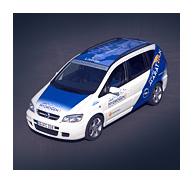GM Minivan Sets New World Record In Fuel Cell Marathon
 |
For more information on the "Opel Fuel Cell Marathon - " visit www.gmeurope.com/marathon.
LISBON, Portugal June 9, 2004; General Motors Corp. set a new world distance record for fuel cell technology today with a run of 6,059 miles through 14 countries when the GM fuel cell powered minivan arrived in Cabo da Roca near Lisbon.
Nearly doubling the previous distance record for fuel cell cars set by DaimlerChrysler in 2002 (3,281 miles from San Francisco to Washington D.C.), the GM fuel cell prototype withstood extreme temperatures and road conditions during its long-distance journey. The marathon began in Hammerfest, the northern tip of Norway on May 13, and finished in Cabo da Roca, the most westerly point of the European continent.
Over the 38 day run, the hydrogen powered car proved that GM is making important progress in its fuel cell technology. With 25 international journalists taking turns at the wheel, the vehicle performed without a single report of an unscheduled stop for repair as it was subjected to high speeds, steep mountain passes and temperature differences of more than 32 degrees Fahrenheit.
"The reliability and overall performance attained by our fuel cell propulsion system in this Marathon drive verifies that we are progressing toward our goal of having this technology commercially viable by 2010," said Larry Burns, vice president of Research Development and Planning. "We have gained some valuable findings from the tough day-to-day marathon schedule."
A software update at the beginning of the tour, the replacement of five temperature sensors and the exchange (twice) of the mechanical parking mechanism were the only necessary repairs. In addition, as part of the inspection performed at the halfway stage (near Darmstadt, Germany, where the GM Marathon vehicle traveled 3,419 miles breaking the record by DaimlerChrysler), the fuel cell stack was changed so that the other journalists who would be driving the car could enjoy optimum performance from the system.
A 60 kW/82 hp electric motor, which is supplied with electric energy from the hydrogen fuel cell stack, supplied the fuel cell with electrical energy and kept the hydrogen-powered vehicle in step with other vehicles on the roadways and highways of Europe. The front-wheel drive vehicle accelerated to 160 kilometers/hour or roughly 100 mph and averaged about 300 miles per day.
Because the hydrogen infrastructure is not available to refuel the vehicle along the route, a mobile fueling station provided by Linde was used to replenish the hydrogen during the long haul. On average, refueling took about four minutes - a time that can certainly be compared with current gasoline refueling procedures.


